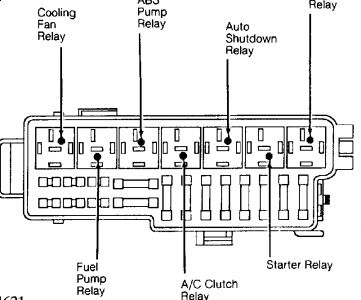We need a fuel pressure reading, and if possible security system status,
TEST NS-2A - INSPECTING FUEL SYSTEM 1. Ensure throttle cables are not holding throttle open. If throttle is held open, repair as necessary. Perform TEST VER-1. If throttle is not held open, using DRB-II, read Throttle Position Sensor (TPS) voltage. 2. If voltage is less than 1.5 volts, go to next step. If voltage is more than 1.5 volts, disconnect TPS connector. Inspect terminals. Repair as necessary. Perform TEST VER-1. If terminals are okay, replace TPS. Perform TEST VER-1. 3. If vehicle is not equipped with a factory vehicle theft alarm, go to next step. If vehicle is equipped with factory vehicle theft alarm, using DRB-II, read theft alarm status. If DRB-II displays FUEL ON, go to next step. If DRB-II does not display FUEL ON, see G - BODY TESTS W/ CODES article in the ENGINE PERFORMANCE. 4. Using DRB-II, actuate fuel system. Listen for fuel pump operation at fuel tank. If fuel pump operation cannot be heard, go to TEST NS-5A. If fuel pump operation can be heard, turn ignition off. 5. Ensure fuel tank is at least 1/4 full. Release fuel pressure. Install a fuel pressure gauge in fuel supply line. Turn ignition on. Using DRB-II, actuate fuel system. Read fuel pressure gauge reading. 6. If fuel pressure is more than 43 psi (3.0 kg/cm 2 ), go to TEST NS-4B. If fuel pressure is not more than 43 psi (3.0 kg/cm 2 ), go to next step. 7. If pressure is less than 34 psi (2.3 kg/cm 2 ), go to TEST NS-4A. If pressure is more than 34 psi (2.3 kg/cm 2 ), go to next step. 8. If vehicle initially started and stalled repeatedly, go to TEST NS-7A. If vehicle did not initially start and stall repeatedly, go to TEST NS-3A.
WARNING: High fuel pressure may be present in fuel lines. Open fuel system with caution. See FUEL PRESSURE RELEASE procedure.
TEST NS-4A - CORRECTING FUEL DELIVERY 1. Record fuel pressure gauge reading. Turn ignition off. Release fuel pressure. Remove fuel pressure gauge. Install fuel pressure gauge between fuel tank and fuel filter. Turn ignition on. 2. Using DRB-II, actuate Auto Shutdown (ASD) fuel system. Record fuel pressure gauge reading. Compare fuel pressure gauge reading with previous reading. If fuel pressure gauge reading is not at least 10 psi more than previous reading, go to step 4). If fuel pressure gauge reading is at least 10 psi more than previous reading, turn ignition off. 3. Inspect fuel lines between fuel filter and fuel rail for restriction. Repair as necessary. Perform TEST VER-1. If no restrictions are observed, replace fuel filter. Perform TEST VER-1. 4. Disconnect fuel return hose at fuel rail. Connect a 6-foot fuel hose to fuel rail. Put other end of 6- foot hose into an approved 2-gallon or more capacity gasoline container. Turn ignition on. Using DRB-II, actuate fuel system. 5. Gently squeeze fuel return hose. Read fuel pressure gauge. Using DRB-II, stop fuel system actuator test. If pressure is more than 34 psi (2.3 kg/cm 2 ), replace fuel pressure regulator. Perform TEST VER-1. If it is less than 34 psi (2.3 kg/cm 2 ), replace fuel pump and sock filter. Perform TEST VER-1. WARNING: High fuel pressure may be present in fuel lines. Open fuel system with caution. See FUEL PRESSURE RELEASE procedure. CAUTION: DO NOT allow fuel pressure to exceed 70 psi (4.9 kg/cm 2 ) when squeezing fuel return hose. In place of activating the ASD relay, with DRB II, got to top right of the page, click More service repairs, then click #8, how to test relays, it explains how to activte and test them. Never mind, here's the link for the relay testing.
https://www.2carpros.com/how_to/how_do_i_check_a_relay.htm

The relay is in the fuse panel under the hood.
Saturday, June 20th, 2009 AT 4:48 PM

